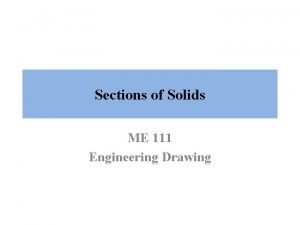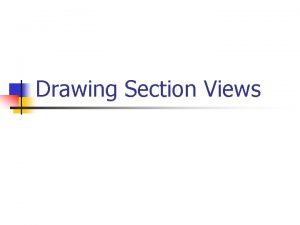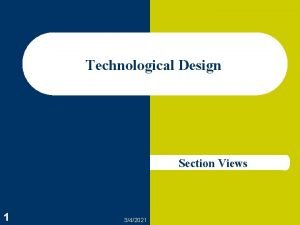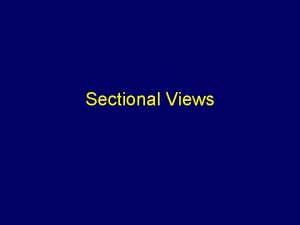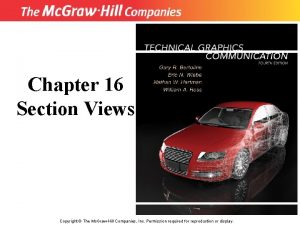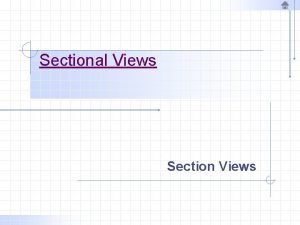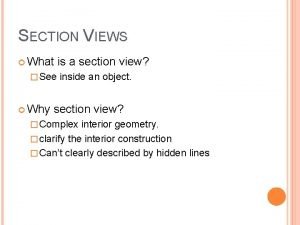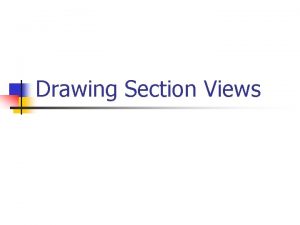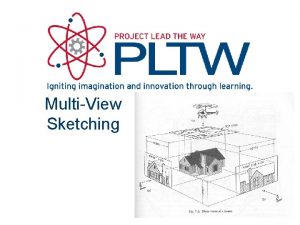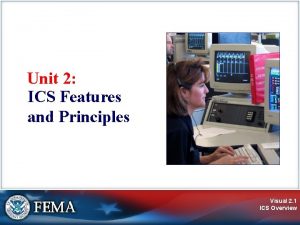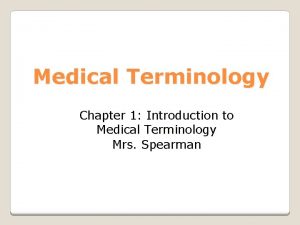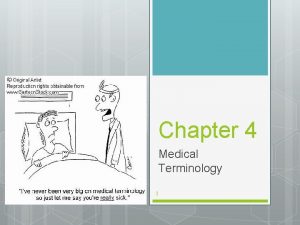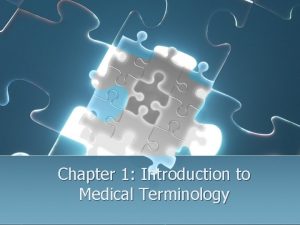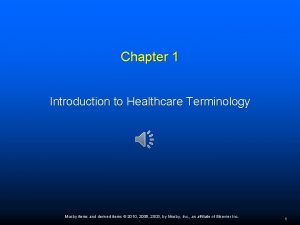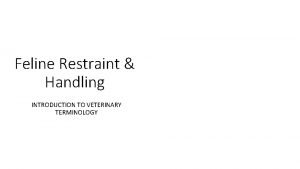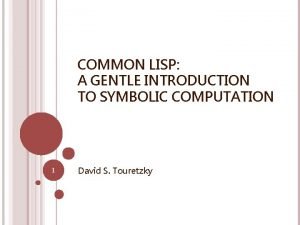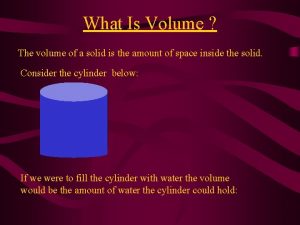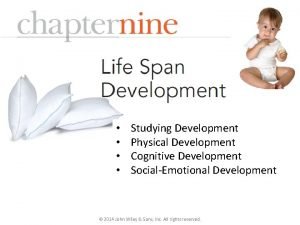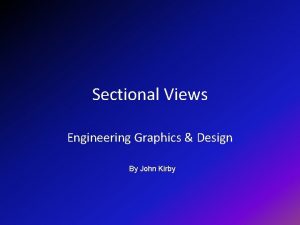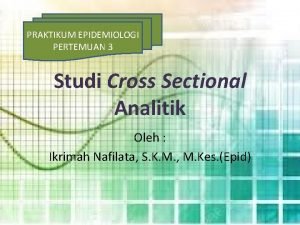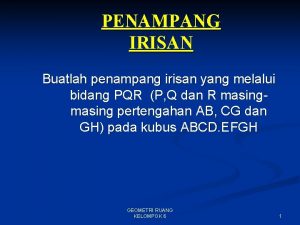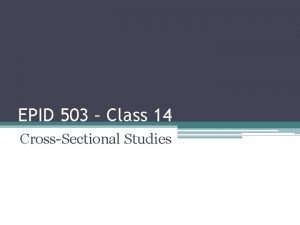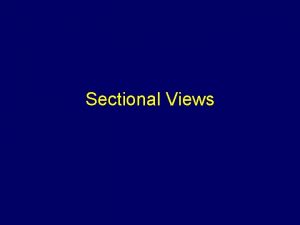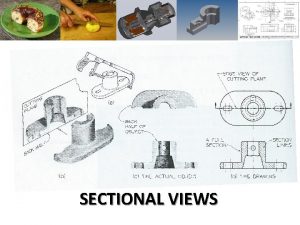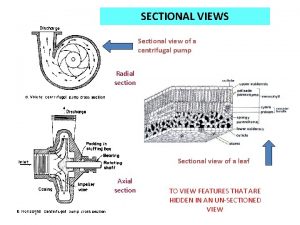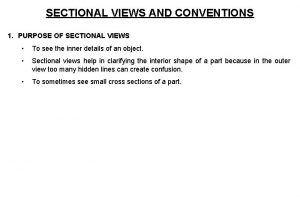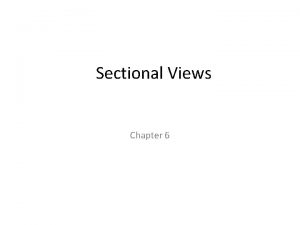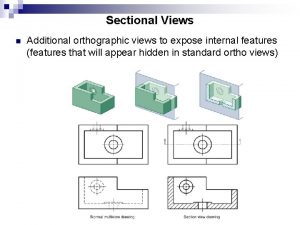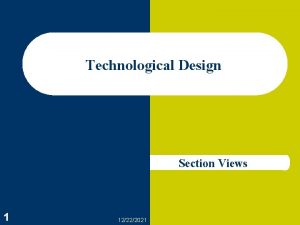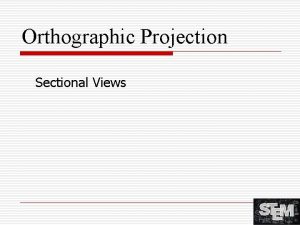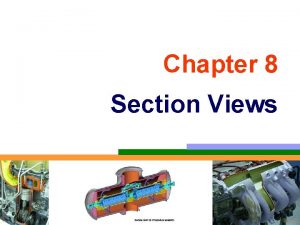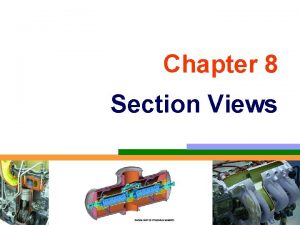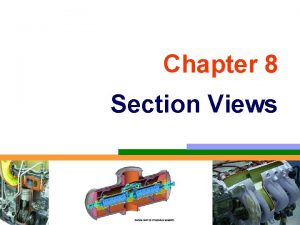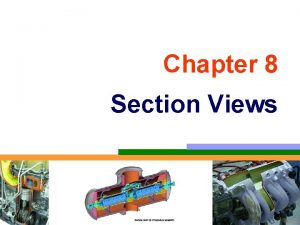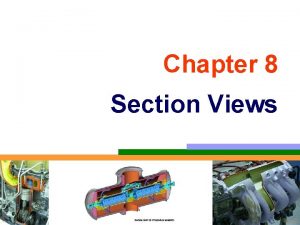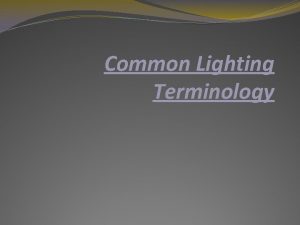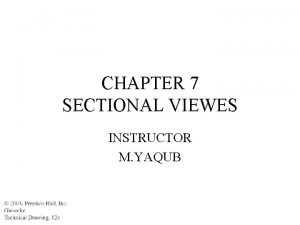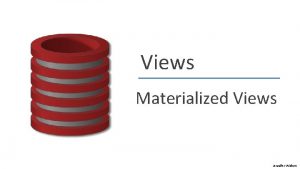Sectional Views TOPICS Introduction Terminology common practices Kind

















































- Slides: 49

Sectional Views

TOPICS Introduction Terminology & common practices Kind of sections Dimensioning

Introduction

PURPOSES OF SECTION VIEWS Clarify the views by v reducing or eliminating the hidden lines. v revealing the cross sectional’s shape. Facilitate the dimensioning. Let See the example

EXAMPLE : Advantage of using a section view.

Terminology and common practices

• Orthographic views showing all hidden lines may not be clear enough to describe an object’s internal details. • This shortcoming can be overcome by imagining that part of the object has been cut away and shown in a cross-sectional view. This view is called a section view.

CUTTING PLANE Cutting plane is a plane that imaginarily cuts the object to reveal the internal features. Cutting plane line Section lines

CUTTING PLANE LINE Cutting plane line is an edge view of the cutting plane. Indicate the path of cutting plane.

CUTTING PLANE LINESTYLES Thick line ANSI standard Thick line Viewing direction JIS & ISO standard Thin line Center line Viewing direction

SECTION LINING Section lines or cross-hatch lines are used to indicate the surfaces that are cut by the cutting plane. Section lines Drawn with 4 H pencil.

SECTION LINES SYMBOLS The section lines are different for each of material’s type. For practical purpose, the cast iron symbol is used most often for any materials. Cast iron, Malleable iron Steel Concrete Sand Wood

SECTION LINING PRACTICE The spaces between lines may vary from 1. 5 mm for small sections to 3 mm for large sections. COMMON MISTAKE

SECTION LINING PRACTICE It should not be drawn parallel or perpendicular to contour of the view. (30, 60) COMMON MISTAKE

Kinds of Sections

KIND OF SECTIONS 1. Full section 2. Offset section 3. Half section 4. Broken-out section 5. Revolved section (aligned section) 6. Removed section (detailed section)

FULL SECTION VIEW The view is made by passing the straight cutting plane completely through the part.

OFFSET SECTION VIEW The view is made by passing the bended cutting plane completely through the part. Do not show the edge views of the cutting plane.

TREATMENT OF HIDDEN LINES Hidden lines are normally omitted from section views.

HALF SECTION VIEW The view is made by passing the cutting plane halfway through an object and remove a quarter of it.

HALF SECTION VIEW A center line is used to separate the sectioned half from the unsectioned half of the view. Hidden line is omitted in unsection half of the view.

BROKEN-OUT SECTION VIEW The view is made by passing the cutting plane normal to the viewing direction and removing the portion of an object in front of it.

BROKEN-OUT SECTION VIEW A break line is used to separate the sectioned portion from the unsectioned portion of the view. Break line is a thin continuous line (4 H) and is drawn freehand. There is no cutting plane line.

EXAMPLE : Comparison among several section techniques

REVOLVED SECTION VIEW Revolved sections show cross-sectional features of a part. No need for additional orthographic views. This section is especially helpful when a cross-section varies.

REVOLVED SECTION VIEW Basic concept

REVOLVED SECTION VIEW Basic concept

REVOLVED SECTION VIEW Steps in construction Given Edge view of cross-section Step 1 a. Assign position of cutting plane. b. Draw axis of rotation in front view.

REVOLVED SECTION VIEW Steps in construction Given Step 2 a. Transfer the depth dimension to the front view.

REVOLVED SECTION VIEW Steps in construction Given Step 3 a. Draw the revolved section. b. Add section lines.

REVOLVED SECTION VIEW Steps in construction Given FINAL PICTURE

REVOLVED SECTION VIEW Placement of revolved section 1. Superimposed to orthographic view. 2. Break from orthographic view. Break Superimposed

REMOVED SECTION VIEW 6. Removed section is revolved section. Section view is shown outside the view. Used where space does not enough for revolved section Can be located elsewhere on a drawing with properly labeled

REMOVED SECTION VIEW Example : Revolved vs. removed sections. Revolved section Removed section

REMOVED SECTION VIEW Example : Situation that removed section is preferred. Poor Too messy !! Preferred

REMOVED SECTION VIEW Example : Multiple removed section views A B B A SECTION B – B SECTION A – A

Dimensioning in Section View

In most cases, dimensioning of the section views follows the typical rules of dimensioning. POOR GOOD

DIMENSIONING 10 10 GOOD POOR f 50

DIMENSIONING For a half-section view, use dimension line with only one arrowhead that points to the position inside the sectioned portion. f 50

Examples








 Section of cone in engineering drawing
Section of cone in engineering drawing In case of half sectioning, of the object is removed.
In case of half sectioning, of the object is removed. Section view definition
Section view definition Section line symbols
Section line symbols Rotated section view
Rotated section view Sectional views reveal
Sectional views reveal What do the arrows on a cutting plane line indicate
What do the arrows on a cutting plane line indicate Sectional views reveal
Sectional views reveal Purpose of sectional views
Purpose of sectional views Section lining symbols
Section lining symbols What is this ?
What is this ? Drawing view types
Drawing view types Multi view drawing
Multi view drawing Gedichte
Gedichte Common kitchen cabinet terminology
Common kitchen cabinet terminology Ics symbol
Ics symbol Chapter 1 introduction to medical terminology answer key
Chapter 1 introduction to medical terminology answer key The word root athr means ________
The word root athr means ________ Medical short hand
Medical short hand Introduction to medical terminology chapter 1
Introduction to medical terminology chapter 1 Chapter 1 introduction to medical terminology
Chapter 1 introduction to medical terminology Rhinoalgia
Rhinoalgia Introduction to veterinary terminology
Introduction to veterinary terminology Factors and multiples of 42
Factors and multiples of 42 Common anode and common cathode
Common anode and common cathode Factor tree of 48
Factor tree of 48 What are the factors for 54
What are the factors for 54 Factors of 12 and 42
Factors of 12 and 42 Multiples of 9 and 21
Multiples of 9 and 21 Common lisp: a gentle introduction to symbolic computation
Common lisp: a gentle introduction to symbolic computation Solid
Solid Plokmijnuhbygvtfcrdxeszwaq games
Plokmijnuhbygvtfcrdxeszwaq games Ovary structures
Ovary structures Anxious ambivalent attachment
Anxious ambivalent attachment Cross sectional research design example
Cross sectional research design example Offset section in engineering drawing
Offset section in engineering drawing Limitations of cross sectional study
Limitations of cross sectional study Research design
Research design Solomon four group design
Solomon four group design Pressed steel reservoirs
Pressed steel reservoirs Cross sectional study adalah
Cross sectional study adalah Cross-sectional plane
Cross-sectional plane Conclusive research design
Conclusive research design Cross-sectional correlational design
Cross-sectional correlational design What is quasi experimental research
What is quasi experimental research Prevalence ratio
Prevalence ratio 40 days baby in womb
40 days baby in womb Disadvantages of cross sectional study
Disadvantages of cross sectional study Cross sectional vs longitudinal
Cross sectional vs longitudinal Sectional air map made of plastic
Sectional air map made of plastic
